Surya (Sun) Namaskaram (Salutation) is the most commonly practiced yoga sequence by many Yoga traditions today. Although the sequence of Sun Salutation does not have any reference in ancient scripts, Surya Namaskaram is one of the main disciplines in the Hindu tradition and its principles are closely associated with the Indian System of Medicines such as Siddha and Ayurveda.
Traditionally, Hindus worship the sun every morning exposing their whole bodies to the rising sun. Later, this practice was formulated as a sequence of Yoga postures. Different traditions practice different variations of Sun Salutation. This ranges from 10, 12, 14 or even 16 steps. Although the number of poses does not matter, it can be modified according to the practitioner’s flexibility and strength. Many Yoga traditions such as Vinyasa yoga, Power Yoga start with Sun Salutation and modify the poses in the middle.
It is good if you can practice Sun Salutation facing the rising sun in the morning and setting sun in the evening. Although Sun Salutation is a good start for Yoga practitioners as a self practice, people with injuries and medical conditions must practice it under expert guidance. Kids will enjoy this practice as it is fun to move around and easy to remember.
• Every month we will feature different variation of Sun Salutation and tips:
• This month’s sequence is focused on the basic to intermediate level yoga practitioners.
• As this sequence involves balancing, lifting poses, practice some warm-ups focusing on the hamstring, wrist stretches and shoulder strengthening poses regularly.
• Practice the first few rounds by holding each pose for 2 – 4 breaths and then slowly adapt the practice to one breath per breath.
• This sequence is best suitable to improve muscle tone, body balance, to improve overall body alignment.
• Start with the few rounds of basic sun salutation sequence before practicing this intermediate level variation.
1. Ekapada Pranamasana – Standing on one-foot prayer pose

Step: Stand tall with the left foot on the floor and bend the right knee up. Bring the palms in Anjali mudra in front of the chest and gaze forward.
Breathing: Normal Breathing
Awareness: Anahata Chakra
Benefits: Helps improve body awareness, physical and mental balance and calms the mind.
Mantra: Om Mitraaya Namaha
2. Uthitha Hastha Eka Padasana

Step: Maintain the balance on the left leg and as you inhale raise the chest up, arms over the head lengthen the spine up.
Breathing: Inhale
Awareness: Swadhisthana Chakra
Benefits: Strengthens and improves the flexibility of the spine, improves circulation and rejuvenates the whole body.
Mantra: Om Ravaye Namaha
3. Veerabhadrasana – Warrior Veerabhadra Pose

Step: Slowly fold forward from the hips and stretch the right leg back and maintain the torso parallel to the floor.
Breathing: Exhale
Awareness: Manipuraha Chakra
Benefits: Good stretch for the hamstrings. Improves hip flexibility and body balance.
Mantra: Om Suryaya Namaha
4. Parsva Veerasana – Sideways Warrior Pose
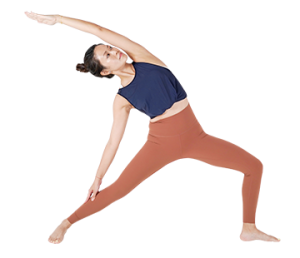
Step: Bring the right leg back and keep the leg straight behind the right hip. Place the left knee above the heel. Inhale as you raise the left arm over the head.
Breathing: Inhale
Awareness: Swadhisthana Chakra
Benefits: Stretches the side of the ribs, strengthens the legs.
Mantra: Om Bhaanave Namaha
5. Uthitha Dandasana – Raise Plank Pose
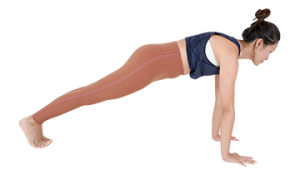
Step: Place the palms on the floor shoulder-width apart. Maintain the arms perpendicular position. Keep the back and legs in one line.
Breathing: Exhale
Awareness: Manipuraha
Benefits: Strengthens the shoulders and abdominal muscles.
Mantra: Om Khagaya Namaha
6. Eka Pada Uthitha Dandasana – One Leg Raised Up Plank Pose
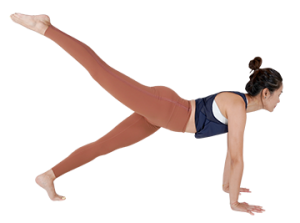
Step: Slowly raise the right leg up as high as possible. Keep the gaze forward.
Breathing: Inhale
Awareness: Mooladhara Chakra
Benefits: Strengthens the gluteus, thighs, and back muscles.
Mantra: Om Pooshne Namaha
7. Bhujangasana – Cobra Pose
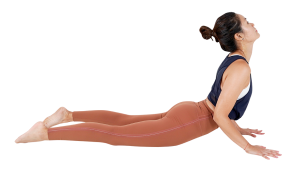
Step: Place the hips on the floor and slightly arch the back.
Breathing: Exhale
Awareness: Swadhisthana Chakra
Benefits: Strengthens and improves the flexibility of the spine. A good stretch for the abdominal organs.
Mantra: Om Hiranya Garbhaya Namaha
8. Eka Pada Uthitha Dandasana – One Leg Raised Up Plank Pose
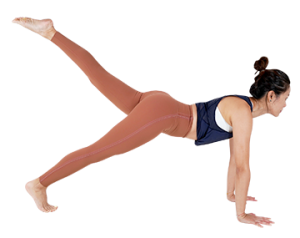
Step: Slowly raise the body up to the high plank pose and raise the left leg up as high as possible. Keep the gaze forward.
Breathing: Inhale
Awareness: Mooladhara Chakra
Benefits: Strengthens the gluteus, thighs, and back muscles.
Mantra: Om Mareechaye Namaha
9. Parsva Veerasana – Sideways Warrior Pose
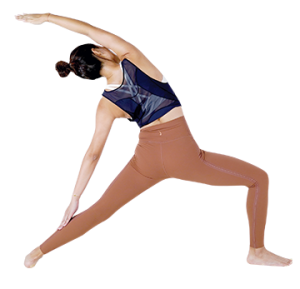
Step: Bring the right leg forward and keep the left leg straight behind the left hip. Place the knee above the heel. Inhale as you raise the right arm over the head.
Breathing: Inhale
Awareness: Swadhisthana Chakra
Benefits: Stretches the side of the ribs, strengthens the legs.
Mantra: Om Aadityaaya Namaha
10. Veerabhadrasana – Warrior Veerabhadra Pose

Step: Slowly lunge forward and raise the left leg up and fold forward from the hips and stretch the left leg back and maintain the torso parallel to the floor.
Breathing: Exhale
Awareness: Manipuraha Chakra
Benefits: Good stretch for the hamstrings. Improves hip flexibility and body balance.
Mantra: Om Savitre Namaha
11. Uthitha Hastha Eka Padasana

Step: Maintain the balance on the right leg and as you inhale raise the chest up, arms over the head lengthen the spine up.
Breathing: Inhale
Awareness: Swadhisthana Chakra
Benefits: Strengthens and improves the flexibility of the spine. improves circulation and rejuvenates the whole body.
Mantra: Om Arkaaya Namaha
12. Ekapada Pranamasana – Standing on one-foot prayer pose

Step: Stand tall with the right foot on the floor and bend the left knee up. Bring the palms in Anjali mudra in front of the chest and gaze forward.
Breathing: Normal Breathing
Awareness: Anahata Chakra
Benefits: Helps improve body awareness, physical and mental balance and calms the mind.
Mantra: Om Bhaskaraya Namaha
Yoga Demonstration by
Ms. April Wong,
Anahata Yoga YTT Graduate.


















 Other
Other